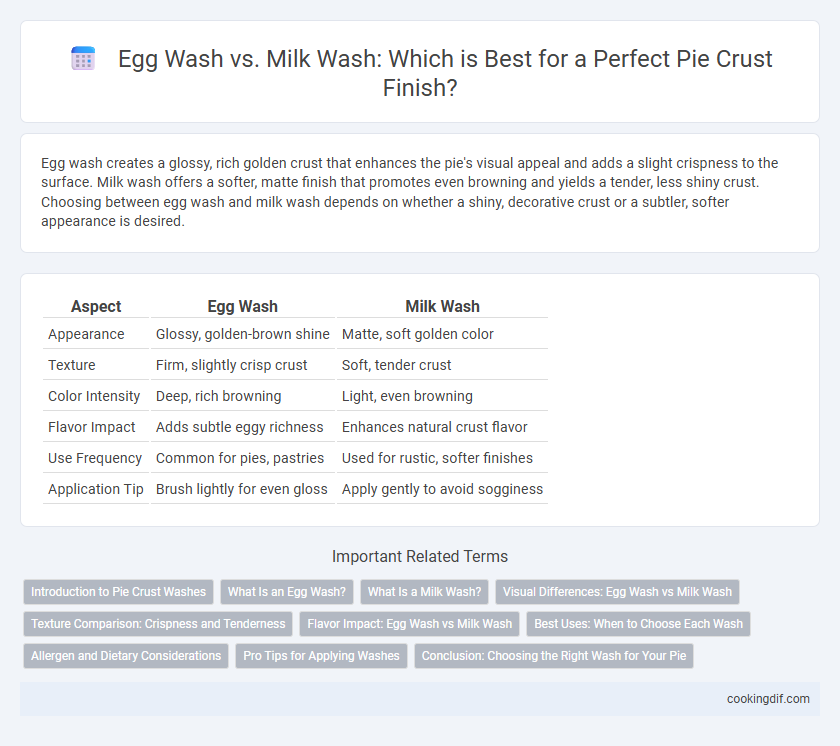Egg wash creates a glossy, rich golden crust that enhances the pie's visual appeal and adds a slight crispness to the surface. Milk wash offers a softer, matte finish that promotes even browning and yields a tender, less shiny crust. Choosing between egg wash and milk wash depends on whether a shiny, decorative crust or a subtler, softer appearance is desired.
Table of Comparison
| Aspect | Egg Wash | Milk Wash |
|---|---|---|
| Appearance | Glossy, golden-brown shine | Matte, soft golden color |
| Texture | Firm, slightly crisp crust | Soft, tender crust |
| Color Intensity | Deep, rich browning | Light, even browning |
| Flavor Impact | Adds subtle eggy richness | Enhances natural crust flavor |
| Use Frequency | Common for pies, pastries | Used for rustic, softer finishes |
| Application Tip | Brush lightly for even gloss | Apply gently to avoid sogginess |
Introduction to Pie Crust Washes
Egg wash and milk wash are popular choices for pie crust finishes, each imparting distinct textures and appearances. Egg wash, made from beaten eggs or egg yolks, creates a glossy, golden-brown crust with a slightly crisp texture, ideal for decorative or lattice-topped pies. Milk wash offers a softer, matte finish and enhances browning through lactose sugars, resulting in a tender crust surface that complements fruit pies and savory dishes.
What Is an Egg Wash?
An egg wash consists of beaten eggs or egg yolks sometimes mixed with water or milk, applied to pie crusts before baking to create a glossy, golden-brown finish. This protein-rich coating enhances browning through the Maillard reaction, resulting in a visually appealing and crisp texture. Egg wash is preferred over milk wash when a shiny, deep color and firmer crust are desired in baked pies.
What Is a Milk Wash?
A milk wash involves brushing milk onto pie crusts before baking to achieve a soft, golden-brown finish with a subtle sheen. Unlike an egg wash, which creates a glossy and more rigid crust, milk wash promotes even browning without adding a shiny surface. Its proteins and sugars gently caramelize, enhancing flavor and texture while maintaining a tender crust appearance.
Visual Differences: Egg Wash vs Milk Wash
Egg wash creates a shiny, golden-brown crust with a slightly thicker and more vibrant finish on pie crusts, enhancing visual appeal through its rich glaze. Milk wash produces a softer, matte golden tone with a more subtle sheen, resulting in a crust with a less glossy, more natural look. The protein and fat content in egg wash contribute to its more pronounced browning effect compared to the gentle coloration achieved by milk wash.
Texture Comparison: Crispness and Tenderness
Egg wash creates a shiny, golden crust with a crisp texture that enhances visual appeal and adds a slight richness. Milk wash produces a softer, more tender crust with a matte finish, contributing to a delicate bite without the pronounced crunch of egg wash. Bakers choose egg wash for appealing crispness and milk wash when aiming for a tender, subtle crust texture.
Flavor Impact: Egg Wash vs Milk Wash
Egg wash imparts a rich, glossy finish with a slightly savory depth that enhances the pie crust's overall flavor, making it more visually appealing and appetizing. Milk wash produces a softer sheen with subtle sweetness, contributing a mild, creamy flavor that complements fruit or custard fillings without overpowering them. Choosing between egg wash and milk wash ultimately influences both the taste profile and exterior texture of the pie crust.
Best Uses: When to Choose Each Wash
Egg wash creates a glossy, golden-brown crust ideal for decorative pies and pastries, enhancing both appearance and texture with its protein-rich composition. Milk wash produces a softer, matte finish with a slightly tender crust, best suited for rustic or flaky pies where a subtle shine is preferred. Choose egg wash for visually striking, firm crusts and milk wash when aiming for a gentle, lightly browned surface that complements delicate fillings.
Allergen and Dietary Considerations
Egg wash provides a glossy, golden crust but contains allergens like eggs, posing risks for those with egg allergies or following vegan diets. Milk wash creates a softer, slightly browned crust and may affect individuals with lactose intolerance or milk allergies. For allergen-free alternatives, water or plant-based milk washes offer safe options while maintaining crust quality.
Pro Tips for Applying Washes
Brushing pie crust with egg wash creates a glossy, golden-brown finish due to the proteins and fats that brown beautifully in the oven. Milk wash yields a softer, more matte crust with a subtle shine, thanks to its natural sugars and fats. For best results, apply wash evenly using a pastry brush, avoid pooling to prevent sogginess, and brush just before baking to maintain optimal crust texture and color.
Conclusion: Choosing the Right Wash for Your Pie
Egg wash enhances pie crusts by creating a shiny, golden-brown finish with a slightly crisp texture, ideal for fruit pies and savory options that need a rich appearance. Milk wash produces a softer, matte finish with a subtle golden hue, perfect for tender, flaky crusts often found in cream or custard pies. Selecting the right wash depends on the desired crust texture and visual appeal, with egg wash suited for bold, glossy results and milk wash favored for delicate, understated finishes.
Egg wash vs milk wash for crust finish Infographic

 cookingdif.com
cookingdif.com